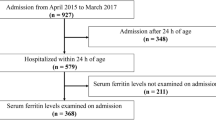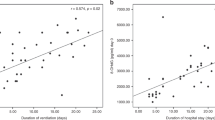Abstract
Objective:
To determine serum thiol-disulfide homeostasis in hyperemesis gravidarum.
Study Design:
Twenty-six pregnant women with hyperemesis gravidarum and 37 healthy pregnant women were included in the study. Native thiol, disulfide and total thiol concentrations were measured with a novel automated method.
Results:
Serum disulfide levels were 15.68±4.41 μmol l−1 in the hyperemesis gravidarum group and 13.49±2.81 μmol l−1 in the healthy group (P=0.031). Native thiol levels were 213.86±26.29 μmol l−1 in the hyperemesis gravidarum group and 232.18±19.21 μmol l−1 in healthy group (P=0.004), and total thiol levels were 245.23±28.58 μmol l−1 in the hyperemesis gravidarum group and 259.17±19.94 μmol l−1 in the healthy group (P=0.038).
Conclusion:
Native and total thiol were deficient in the hyperemesis gravidarum group and this deficiency was correlated with the severity of the disease. The thiol-disulfide balance has shifted to the oxidative side. This metabolic disturbance may have a role in the pathogenesis of hyperemesis gravidarum.
This is a preview of subscription content, access via your institution
Access options
Subscribe to this journal
Receive 12 print issues and online access
$259.00 per year
only $21.58 per issue
Buy this article
- Purchase on Springer Link
- Instant access to full article PDF
Prices may be subject to local taxes which are calculated during checkout



Similar content being viewed by others
References
Niebyl JR . Clinical practice. Nausea and vomiting in pregnancy. N Engl J Med 2010; 363: 1544–1550.
Miller F . Nause and vomiting in pregnancy: the problem of perception —is it really a disease? Am J Obstet Gynecol 2002; 186 (5 Suppl): 182–183.
Bailit JL . Hyperemesis gravidarum: epidemiologic findings from large cohort. Am J Obstet Gynecol 2005; 193 (3 Pt 1): 811–814.
Tan PC, Tan NC, Omar SZ . Effect of high levels of human chorionic gonadotropin and estradiol on the severity of hyperemesis gravidarum. Clin Chem Lab Med 2009; 47 (2): 165–171.
Tan JYL, Loh KC, Yeo GSH, Chee YC . Transient hyperthyroidism of hyperemesis gravidarum. BJOG 2002; 109: 683–688.
Sandven I, Abdelnoor M, Nesheim BI, Melby KK . Helicobacter pylori infection and hyperemesis gravidarum: a systematic review and meta-analysis of case-control studies. Acta Obstet Gynecol Scand 2009; 88 (11): 1190–1200.
Tan PC, Vani S, Lim BK, Omar SZ . Anxiety and depression in hyperemesis gravidarum: prevalence, risk factors and correlation with clinical severity. Eur J Obstet Gynecol Reprod Biol 2010; 149 (2): 153–158.
Verberg MFG, Gillot DJ, Al-Fardan N, Grudzinskas JG . Hyperemesis gravidarum, a literature review. Hum Reprod Update 2005; 11: 527–539.
Agarwal A, Gupta S, Sikka S . The role of free radicals and antioxidants in reproduction. Curr Opin Obstet Gynecol 2006; 18: 325–332.
Fait V, Sela S, Ophir E, Khoury S, Nissimov J, Tkach M et al. Hyperemesis gravidarum is associated with oxidative stress. Am J Perinatol 2002; 19: 93–98.
Celik F, Guzel AI, Kuyumcuoglu U, Celik Y . Dietary antioxidant levels in hyperemesis gravidarum: a case control study. Ginekol Pol 2011; 82 (11): 840–844.
Van Stuijvenberg ME, Schabort I, Labadarios D, Nel JT . The nutritional status and treatment of patients with hyperemesis gravidarum. Am J Obstet Gynecol 1995; 172: 1585–1591.
Guney M, Oral B, Mungan T . Serum lipid peroxidation and antioxidant potential levels in hyperemesis gravidarum. Am J Perinatol 2007; 24: 283–289.
Cevrioglu AS, Altindis M, Yilmazer M, Fenkci IV, Ellidokuz E, Kose S . Efficient and non-invasive method for investigating Helicobacter pylori in gravida with hyperemesis gravidarum: Helicobacter pylori stool antigen test. J Obstet Gynaecol Res 2004; 30: 136–141.
Aksoy H, Aksoy AN, Ozkan A, Polat H . Serum lipid profile, oxidative status, and paraoxonase 1 activity in hyperemesis gravidarum. J Clin Lab Anal 2009; 23: 105–109.
Verit FF, Erel O, Celik H . Paraoxonase-1 activity in patients with hyperemesis gravidarum. Redox Rep 2008; 13 (3): 134–138.
Kayalı R, Çakatay U . Protein oksidasyonunun ana mekanizmaları. Cerrahpaşa J Med 2004; 35 (2): 83–89.
Sung CC, Hsu YC, Chen CC, Lin YF, Wu CC . Oxidative stress and nucleic acid oxidation in patients with chronic kidney disease. Oxid Med Cell Longev 2013; 2013: 301982.
Kumari M.V., Hiramatsu M., Ebadi M . Free radical scavenging actions of metallothionein isoforms I and II. Free Radic Res 1998; 29: 93–101.
Sen CK, Packer L . Thiol homeostasis and supplements in physical exercise. Am J Clin Nutr 2000; 72 (2 Suppl.): 653S–669SS.
Turell L, Radi R, Alvarez B . The thiol pool in human plasma: the central contribution of albumin to redox processes. Free Radic Biol Med 2013; 65: 244–253.
Jones DP, Liang Y . Measuring the poise of thiol/disulfide couples in vivo. Free Radic Biol Med 15; 2009; 47 (10): 1329–1338.
Circu ML . AwTY. Reactive oxygen species, cellular redox systems, and apoptosis. Free Radic Biol Med 2010; 48 (6): 749–762.
Biswas S, Chida AS, Rahman I . Redox modifications of protein–thiols: emerging roles in cell signaling. Biochem Pharmacol 2006; 71 (5): 551–564.
Ellman G, Lysko H . A precise method for the determination of plasma sulfhydryl groups. Anal Biochem 1979; 93 (1): 98–102.
Erel O, Neselioglu S . A novel and automated assay for thiol/disulphide homeostasis. Clin Biochem 2014; 47 (18): 326–332.
Bashiri A, Neumann L, Maymon E, Katz M . Hyperemesis gravidarum: epidemiologic features, complications and outcome. Eur J Obstet Gynecol Reprod Biol 1995; 63: 135–138.
Tan PC, Jacob R, Quek KF, Omar SZ . Pregnancy outcome in hyperemesis gravidarum and the effect of laboratory clinical indicators of hyperemesis severity. J Obstet Gynaecol Res 2007; 33 (4): 457–464.
Jacob C., Anwar A . The chemistry behind redox regulation with a focus on sulphur redox systems. Physiol Plant 2008; 133: 469–480.
Hansen RE, Østergaard H, Winther JR . Increasing the reactivity of an artificial dithioldisulfide pair through modification of the electrostatic milieu. Biochemistry 2005; 44: 5899–5906.
Wouters MA, George RA, Haworth NL . ‘Forbidden’ disulfides: their role as redox switches. Curr Protein Pept Sci 2007; 8: 484–495.
Matteucci E, Giampietro O . Thiol signalling network with an eye to diabetes. Molecules 2010; 15 (12): 8890–8903.
Prabhu A, Sarcar B, Kahali S, Yuan Z, Johnson JJ, Adam KP et al. Cysteine catabolism:a novel metabolic pathway contributing to glioblastoma growth. Cancer Res 2014; 4 (3): 787–796.
Rodrigues SD, Batista GB, Ingberman M, Pecoits-Filho R, Nakao LS . Plasma cysteine/cystine reduction potential correlates with plasma creatinine levels in chronic kidney disease. Blood Purif 2012; 34 (3–4): 231–237.
Quinlan JD, Hill DA . Nausea and vomiting of pregnancy. Am Fam Physician 2003; 68: 121–128.
Onaran Y, Kafali H, Duvan Cİ, Keskin E, Celik H, Erel O . Relationship between oxidant and antioxidant activity in hyperemesis gravidarum. J Matern Fetal Neonatal Med 2014; 27 (8): 825–828.
Yilmaz S, Ozgu-Erdinc AS, Demirtas C, Ozturk G, Erkaya S, Uygur D . The oxidative stress index increases among patients with hyperemesis gravidarum but not in normal pregnancies. Redox Rep 2014; 20: 97–102.
Erel O . A novel automated direct measurement method for total antioxidant capacity using a new generation, more stable ABTS radical cation. Clin Biochem 2004; 37: 277–285.
Ingenbleek Y . The nutritional relationship linking sulfur to nitrogen in living organisms. J Nutr 2006; 136: 1641S–1651S.
Shibata E, Ejima K, Nanri H, Toki N, Koyama C, Ikeda M. et al. Enhanced protein levels of protein thiol/disulphide oxidoreductases in placentae from pre-eclamptic subjects. Placenta 2001; 22: 566–572.
Llurba E, Grataco E, Martın-Gallan P, Cabero L, Domınguez C . A comprehensıve study of oxıdatıve stress and antıoxıdant status ın preeclampsıa and normal pregnancy. Free Radıcal Bıo Med 2004; 37: 557–570.
Sahlin L, Ostlund E, Wang H, Holmgren A, Fried G . Decreased expression of thioredoxin and glutaredoxin in placentas from pregnancies with pre-eclampsia and ıntrauterine growth restriction. Placenta 2000; 21: 603–609.
Sawicki G, Dakour J, Morrish DW . Functional proteomics of neurokinin B in the placenta indicates a novel role in regulating cytotrophoblast antioxidant defences. Proteomics 2003; 3: 2044–2051.
Kharb S . Total radical-trapping antioxidant potential in gestational diabetes. Int J Gynaecol Obstet 2008; 103: 257–258.
Vural M, Camuzcuoglu H, Toy H, Cece H, Aydin H, Eren MA et al. Evaluation of the future atherosclerotic heart disease with oxidative stress and carotid artery intima media thickness in gestational diabetes mellitus. Endocr Res 2012; 37 (3): 145–153.
Author information
Authors and Affiliations
Corresponding author
Ethics declarations
Competing interests
The authors declare no conflict of interest.
Rights and permissions
About this article
Cite this article
Ergin, M., Cendek, B., Neselioglu, S. et al. Dynamic thiol-disulfide homeostasis in hyperemesis gravidarum. J Perinatol 35, 788–792 (2015). https://doi.org/10.1038/jp.2015.81
Received:
Revised:
Accepted:
Published:
Issue Date:
DOI: https://doi.org/10.1038/jp.2015.81
This article is cited by
-
Protective Effects of Boron on Cyclophosphamide-Induced Bladder Damage and Oxidative Stress in Rats
Biological Trace Element Research (2020)
-
Assessment of Oxidative Stress in Patients with Sudden Hearing Loss: A Non-randomized Prospective Clinical Study
Indian Journal of Otolaryngology and Head & Neck Surgery (2019)



